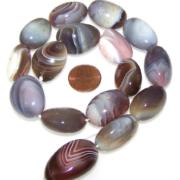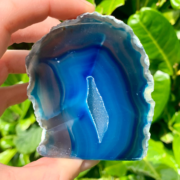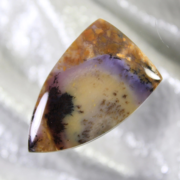Wind Fossil Agate
Wind Fossil Agate is a type of agate gemstone renowned for its captivating patterns resembling wind-blown sand or fossilized organic matter. It is a variety of chalcedony, a form of quartz, distinguished by its unique banding and inclusions.
 Wind Fossil Agate different shapes from £4 (crystalwise.co)
Wind Fossil Agate different shapes from £4 (crystalwise.co)
The name “Wind Fossil Agate” stems from the intricate designs within the stone, which evoke imagery of windswept landscapes or the imprints of ancient organisms preserved in rock. These patterns can vary widely, ranging from subtle wisps to bold, dramatic swirls, making each piece of Wind Fossil Agate truly one-of-a-kind.
This gemstone is formed through a process of sedimentary deposition and mineralization over millions of years. As water rich in silica percolates through porous rocks, it carries dissolved minerals that gradually accumulate in cavities or fractures within the host rock. Over time, these minerals crystallize, forming the characteristic bands and inclusions that give Wind Fossil Agate its distinct appearance.
Wind Fossil Agate is prized not only for its aesthetic appeal but also for its metaphysical properties. It is believed to possess grounding and stabilizing energies, helping to promote a sense of balance and harmony. Additionally, like other forms of agate, it is associated with protection and strength, making it a popular choice for jewelry and spiritual practices.
Overall, Wind Fossil Agate stands as a testament to the beauty and complexity of nature, offering both visual delight and symbolic significance to those who admire and appreciate its splendor.
Contents
- Geological Formation Process
- Physical Properties of Wind Fossil Agate
- Locations and Occurrences
- Uses and Applications
Geological Formation Process

The formation of Wind Fossil Agate is a fascinating geological process that unfolds over millions of years. It begins with the deposition of sedimentary materials such as sand, silt, and clay in ancient environments such as riverbeds, lake bottoms, or ocean floors. Over time, these sediments accumulate in layers, gradually compacting and cementing into sedimentary rocks like sandstone or limestone.
As this sedimentary rock undergoes geological processes such as tectonic activity or volcanic eruptions, it can develop fractures, cavities, or voids within its structure. These void spaces provide opportunities for mineral-rich fluids, typically silica-rich solutions, to percolate through the rock.
The silica-rich fluids, often sourced from volcanic activity or hydrothermal vents deep within the Earth’s crust, infiltrate the cavities and fractures within the host rock. As the fluids cool and evaporate, the dissolved silica precipitates out of solution, gradually crystallizing into microcrystalline quartz, which is the primary component of agate.
Over time, layers of silica continue to accumulate within these cavities, forming concentric bands or other intricate patterns characteristic of agate. The specific colors and patterns of Wind Fossil Agate are influenced by the presence of trace elements and minerals during the crystallization process.
The “fossil” aspect of Wind Fossil Agate refers to the intricate patterns within the stone that resemble organic shapes or fossilized remains. These patterns are formed through various processes, including the inclusion of organic material such as plant debris or microorganisms during the initial sedimentation, or through the migration of mineral-rich fluids that interact with the surrounding rock.
As the agate formation process progresses, these organic inclusions may become fossilized or preserved within the crystalline structure of the stone, adding to its unique visual appeal and charm.
In summary, Wind Fossil Agate is formed through a combination of sedimentary deposition, mineralization, and geological processes that occur over vast spans of time. Its intricate patterns and fossil-like appearances are a testament to the dynamic interplay of geological forces and natural phenomena that shape the Earth’s crust.
Physical Properties of Wind Fossil Agate

Wind Fossil Agate possesses a variety of physical properties that contribute to its distinctive appearance and appeal. Here are some of its key characteristics:
- Color: Wind Fossil Agate exhibits a wide range of colors, including earthy tones such as beige, brown, gray, and black, often with subtle or contrasting banding patterns. These colors are influenced by the presence of trace minerals and other impurities during the stone’s formation.
- Transparency: Wind Fossil Agate is typically translucent to opaque, with varying degrees of transparency depending on the specific composition and structure of the stone. Some specimens may allow light to pass through more readily than others, creating intriguing visual effects.
- Luster: The luster of Wind Fossil Agate can vary from dull to vitreous (glassy) depending on the surface finish and the presence of microscopic crystalline structures within the stone.
- Texture: Wind Fossil Agate often exhibits a smooth, polished texture when cut and polished, although natural variations in texture may be present due to the presence of inclusions or irregularities in the stone.
- Hardness: On the Mohs scale of mineral hardness, Wind Fossil Agate typically has a hardness ranging from 6.5 to 7. This makes it relatively durable and suitable for a wide range of jewelry and ornamental purposes.
- Fracture: Wind Fossil Agate typically displays a conchoidal fracture, meaning it breaks with smooth, curved surfaces resembling the inside of a seashell. This fracture pattern is characteristic of many types of chalcedony, including agate.
- Density: The density of Wind Fossil Agate varies depending on its specific composition and porosity but generally falls within the range of 2.58 to 2.64 grams per cubic centimeter.
- Pattern: One of the most distinctive features of Wind Fossil Agate is its intricate banding patterns and fossil-like inclusions. These patterns can vary widely, ranging from subtle swirls and wisps to bold, dramatic designs reminiscent of windswept landscapes or ancient organic matter preserved in stone.
Overall, the physical properties of Wind Fossil Agate contribute to its allure and versatility, making it a prized gemstone for jewelry, decorative objects, and metaphysical practices.
Locations and Occurrences
 Windfossil Agate Beads (crystalwise.co)
Windfossil Agate Beads (crystalwise.co)
Wind Fossil Agate is found in various locations around the world, each with its own unique characteristics and qualities. Some of the notable occurrences include:
- Madagascar: Madagascar is known for producing high-quality Wind Fossil Agate with intricate banding patterns and vibrant colors. The agate deposits in Madagascar often yield specimens with striking contrasts and unique fossil-like inclusions.
- United States (Oregon): Oregon is renowned for its agate deposits, including Wind Fossil Agate. The state’s agate beds, particularly in areas like Succor Creek and Graveyard Point, produce specimens with diverse colors and patterns, including the characteristic wind-blown designs.
- Brazil: Brazil is a significant source of agate, including Wind Fossil Agate. The country’s agate deposits, particularly in the Rio Grande do Sul region, produce specimens with a wide range of colors and patterns, often featuring intricate banding and fossil-like inclusions.
- Mexico: Mexico is another notable producer of Wind Fossil Agate. The country’s agate deposits, found in regions such as Chihuahua and Durango, yield specimens with diverse colors and patterns, including the characteristic wind-blown designs and fossil-like inclusions.
- India: India is known for its agate deposits, although Wind Fossil Agate occurrences are relatively less common compared to other countries. Nevertheless, Indian agate can exhibit beautiful banding patterns and colors, making it sought after by collectors and artisans.
- Other Locations: Wind Fossil Agate can also be found in various other countries and regions around the world, including Australia, Botswana, China, and Uruguay, among others. Each location offers its own unique variations of Wind Fossil Agate, adding to the diversity and appeal of this captivating gemstone.
These locations represent just a few examples of where Wind Fossil Agate is found. The geological processes and specific mineral compositions in each region contribute to the unique characteristics of the agate specimens produced, making them highly sought after by collectors, lapidaries, and jewelry enthusiasts worldwide.
Uses and Applications

Wind Fossil Agate is prized for its beauty and versatility, making it suitable for a variety of uses and applications. Some of the common uses and applications of Wind Fossil Agate include:
- Jewelry: Wind Fossil Agate is frequently used in jewelry making due to its attractive colors, patterns, and durability. It is often cut and polished into cabochons, beads, pendants, and other forms for use in earrings, necklaces, bracelets, and rings. The unique banding patterns and fossil-like inclusions of Wind Fossil Agate add visual interest to jewelry designs, making each piece distinctive and eye-catching.
- Ornamental Objects: Wind Fossil Agate is also utilized in the creation of ornamental objects and decorative items. It can be fashioned into sculptures, carvings, paperweights, and other artistic creations, showcasing its natural beauty and enhancing interior decor.
- Metaphysical and Healing Practices: In various cultures and belief systems, Wind Fossil Agate is believed to possess metaphysical properties that promote grounding, stability, protection, and strength. It is often used in crystal healing practices, meditation, and energy work to balance and harmonize the mind, body, and spirit.
- Lapidary Art: Wind Fossil Agate is favored by lapidaries and artisans for its workability and aesthetic appeal. It can be shaped, polished, and engraved to create intricate designs and patterns, showcasing the natural beauty of the stone in artistic expressions.
- Collecting and Display: Wind Fossil Agate is highly sought after by collectors for its rarity, beauty, and unique characteristics. Collectors may seek out specimens with specific colors, patterns, or fossil-like inclusions to add to their collections or display in their homes, offices, or museums.
- Gifts and Souvenirs: Wind Fossil Agate jewelry, decorative items, and other products make meaningful and memorable gifts for special occasions such as birthdays, anniversaries, holidays, and graduations. They serve as reminders of natural beauty and can hold personal significance for the recipient.
Overall, Wind Fossil Agate offers a wide range of uses and applications, from adornment and decoration to spiritual practices and artistic expression. Its timeless appeal and inherent beauty continue to captivate and inspire people around the world.





Leave a Reply
Want to join the discussion?Feel free to contribute!